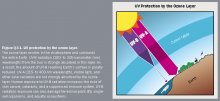Ozone depletion Environmental Issues
The Connection between Ozone Layer Depletion and UVB Radiation
Reduced ozone levels as a result of mean less protection from the sun’s rays and more exposure to radiation at the Earth’s surface. Studies have shown that in the Antarctic, the amount of UVB measured at the surface can double during the annual ozone hole.
Effects on Human Health
Ozone layer depletion increases the amount of UVB that reaches the Earth’s surface. Laboratory and epidemiological studies demonstrate that UVB causes non-melanoma skin cancer and plays a major role in malignant melanoma development. In addition, UVB has been linked to the development of cataracts, a clouding of the eye’s lens.
 Source: Figure Q3-1 from Michaela I. Hegglin (Lead Author), David W. Fahey, Mack McFarland, Stephen A. Montzka, and Eric R. Nash, Twenty Questions and Answers About the Ozone Layer: 2014 Update, Scientific Assessment of Ozone Depletion: 2014, 84 pp., World Meteorological Organization, Geneva, Switzerland, 2015. Because all sunlight contains some UVB, even with normal stratospheric ozone levels, it is always important to protect your skin and eyes from the sun. See a more detailed explanation of health effects linked to UVB exposure.
Source: Figure Q3-1 from Michaela I. Hegglin (Lead Author), David W. Fahey, Mack McFarland, Stephen A. Montzka, and Eric R. Nash, Twenty Questions and Answers About the Ozone Layer: 2014 Update, Scientific Assessment of Ozone Depletion: 2014, 84 pp., World Meteorological Organization, Geneva, Switzerland, 2015. Because all sunlight contains some UVB, even with normal stratospheric ozone levels, it is always important to protect your skin and eyes from the sun. See a more detailed explanation of health effects linked to UVB exposure.
EPA uses the Atmospheric and Health Effects Framework model to estimate the health benefits of stronger ozone layer protection under the Montreal Protocol. Updated information on the benefits of EPA’s efforts to address ozone layer depletion is available in a 2015 report, Updating Ozone Calculations and Emissions Profiles for Use in the Atmospheric and Health Effects Framework Model.
Effects on Plants
UVB radiation affects the physiological and developmental processes of plants. Despite mechanisms to reduce or repair these effects and an ability to adapt to increased levels of UVB, plant growth can be directly affected by UVB radiation.
Indirect changes caused by UVB (such as changes in plant form, how nutrients are distributed within the plant, timing of developmental phases and secondary metabolism) may be equally or sometimes more important than damaging effects of UVB. These changes can have important implications for plant competitive balance, herbivory, plant diseases, and biogeochemical cycles.
Effects on Marine Ecosystems
Phytoplankton form the foundation of aquatic food webs. Phytoplankton productivity is limited to the euphotic zone, the upper layer of the water column in which there is sufficient sunlight to support net productivity. Exposure to solar UVB radiation has been shown to affect both orientation and motility in phytoplankton, resulting in reduced survival rates for these organisms. Scientists have demonstrated a direct reduction in phytoplankton production due to ozone depletion-related increases in UVB.
UVB radiation has been found to cause damage to early developmental stages of fish, shrimp, crab, amphibians, and other marine animals. The most severe effects are decreased reproductive capacity and impaired larval development. Small increases in UVB exposure could result in population reductions for small marine organisms with implications for the whole marine food chain.
Effects on Biogeochemical Cycles
Increases in UVB radiation could affect terrestrial and aquatic biogeochemical cycles, thus altering both sources and sinks of greenhouse and chemically important trace gases (e.g., carbon dioxide, carbon monoxide, carbonyl sulfide, ozone, and possibly other gases). These potential changes would contribute to biosphere-atmosphere feedbacks that mitigate or amplify the atmospheric concentrations of these gases.
Effects on Materials
Synthetic polymers, naturally occurring biopolymers, as well as some other materials of commercial interest are adversely affected by UVB radiation. Today's materials are somewhat protected from UVB by special additives. Yet, increases in UVB levels will accelerate their breakdown, limiting the length of time for which they are useful outdoors.









